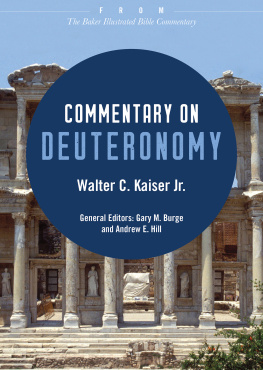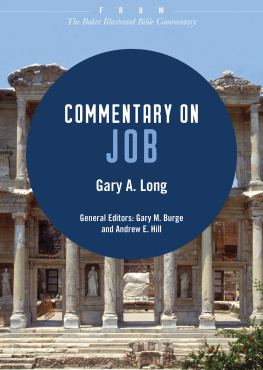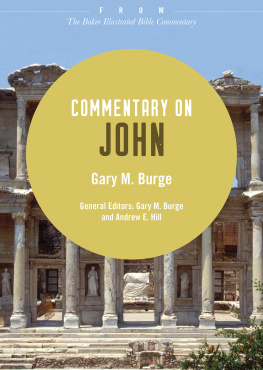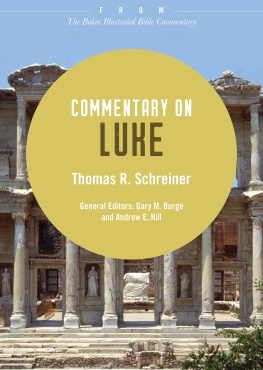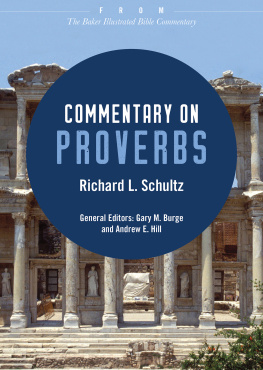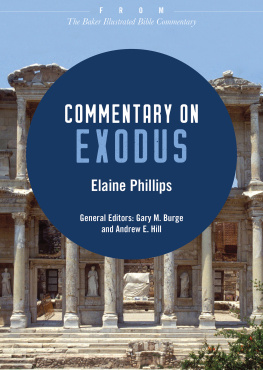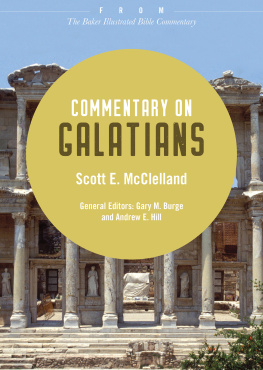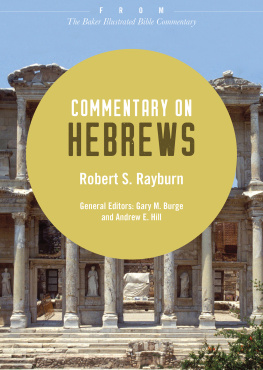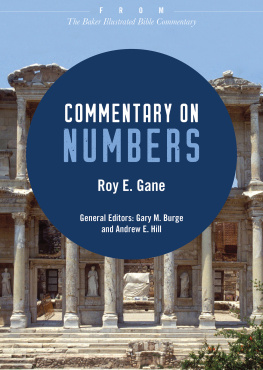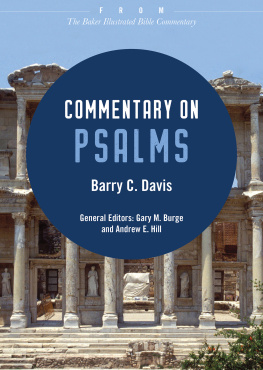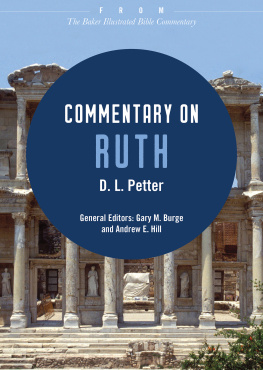Copyright Page
2012 by Baker Publishing Group
Published by Baker Books
a division of Baker Publishing Group
P.O. Box 6287, Grand Rapids, MI 49516-6287
www.bakerbooks.com
Ebook short created 2019
Previously published in The Baker Illustrated Bible Commentary edited by Gary M. Burge and Andrew E. Hill in 2012
All rights reserved. No part of this publication may be reproduced, stored in a retrieval system, or transmitted in any form or by any meansfor example, electronic, photocopy, recordingwithout the prior written permission of the publisher. The only exception is brief quotations in printed reviews.
Library of Congress Cataloging-in-Publication Data is on file at the Library of Congress, Washington, DC.
ISBN 978-1-4934-2443-6
Unless otherwise indicated, Scripture quotations are from the Holy Bible, New International Version. NIV. Copyright 1973, 1978, 1984, 2011 by Biblica, Inc. Used by permission of Zondervan. All rights reserved worldwide. www.zondervan.com. The NIV and New International Version are trademarks registered in the United States Patent and Trademark Office by Biblica, Inc.
Scripture quotations labeled ESV from The Holy Bible, English Standard Version (ESV), copyright 2001 by Crossway, a publishing ministry of Good News Publishers. Used by permission. All rights reserved. ESV Text Edition: 2007
Scripture quotations labeled NASB are from the New American Standard Bible, copyright 1960, 1962, 1963, 1968, 1971, 1972, 1973, 1975, 1977, 1995 by The Lockman Foundation. Used by permission. www.lockman.org
Scripture quotations labeled NIV 1984 are from the HOLY BIBLE, NEW INTERNATIONAL VERSION. NIV. Copyright 1973, 1978, 1984 by International Bible Society. Used by permission of Zondervan. All rights reserved.
Scripture quotations labeled NJPS are from the New Jewish Publication Society Version 1985 by The Jewish Publication Society. All rights reserved.
Scripture quotations labeled NKJV are from the New King James Version. Copyright 1982 by Thomas Nelson, Inc. Used by permission. All rights reserved.
Scripture quotations labeled NLT are from the Holy Bible , New Living Translation, copyright 1996, 2004, 2007 by Tyndale House. Used by permission of Tyndale House Publishers, Inc., Carol Stream, Illinois 60188. All rights reserved.
Scripture quotations labeled NRSV are from the New Revised Standard Version of the Bible, copyright 1989, by the Division of Christian Education of the National Council of the Churches of Christ in the United States of America. Used by permission. All rights reserved.
Scripture quotations labeled RSV are from the Revised Standard Version of the Bible, copyright 1952 [2nd edition, 1971] by the Division of Christian Education of the National Council of the Churches of Christ in the United States of America. Used by permission. All rights reserved.
Unless otherwise indicated, photos, illustrations, and maps are copyright Baker Photo Archive.
Contents
Abbreviations
| ANET | Ancient Near Eastern Texts Relating to the Old Testament . Edited by J. B. Pritchard. 3rd ed. Princeton, 1969 |
| BDAG | Bauer, W., F. W. Danker, W. F. Arndt, and F. W. Gingrich. Greek-English Lexicon of the New Testament and Other Early Christian Literature. 3rd ed. Chicago, 1999 |
| ca. | circa (about, approximately) |
| cf. | compare |
| chap(s). | chapter(s) |
| COS | The Context of Scripture . Edited by W. W. Hallo. 3 vols. Leiden, 1997 |
| e.g. | for example |
| ESV | English Standard Version |
| HALOT | Koehler, L., W. Baumgartner, and J. J. Stamm. The Hebrew and Aramaic Lexicon of the Old Testament. Translated and edited under the supervision of M. E. J. Richardson. 5 vols. Leiden, 19942000 |
| HCSB | Holman Christian Standard Bible |
| i.e. | that is |
| KJV | King James Version |
| NASB | New American Standard Bible |
| NEB | New English Bible |
| NET | New English Translation |
| NIV | New International Version (2011 edition) |
| NIV 1984 | New International Version (1984 edition) |
| NJB | New Jerusalem Bible |
| NJPS | The Tanakh: The Holy Scriptures: The New JPS Translation according to the Traditional Hebrew Text |
| NKJV | New King James Version |
| NLT | New Living Translation |
| NRSV | New Revised Standard Version |
| RSV | Revised Standard Version |
| TDOT | Theological Dictionary of the Old Testament . Edited by G. J. Botterweck and H. Ringgren. Translated by J. T. Willis, G. W. Bromiley, and D. E. Green. 8 vols. Grand Rapids, 1974 |
| TNIV | Todays New International Version |
Deuteronomy
Walter C. Kaiser Jr.
Introduction
For all too many, this book sounds to them like Duty-onomy. But how could that be, when Deuteronomy has been praised as the heartbeat and the most influential book of the Old Testament? If we add the testimony of Jesus, Paul, and the early church, Deuteronomy may well be the most significant book in the whole canon of Scripture. In fact, there are some 103 allusions or references to Deuteronomy in the Gospel of John alone. While it represents the climax of the five books of Moses, it is also a prophetic book; Moses was among the first and the greatest of Israels prophets.
Title
The English title for this book comes from the Greek translation of Deuteronomy 17:18, which speaks of the king having a copy of the law. The Greek Septuagint inaccurately rendered this verse as deuteronomion , meaning second law. However, this book is not a second law but a renewal of the covenant Moses made at Mount Sinai, which site is also called Mount Horeb.
Rather than giving a title for each book, the Hebrew Bible follows the ancient custom of naming a book by its opening line. In Hebrew, Deuteronomy starts with, these are the words; therefore it was simply called Debarim , The Words.

Structure
There are at least three different ways this book can be examined: (1) as the three great speeches of Moses, (2) as a text exhibiting the form of the vassal treaties of the great kings of the second millennium BC, or (3) as an expanded exposition on the Decalogue, the Ten Commandments.
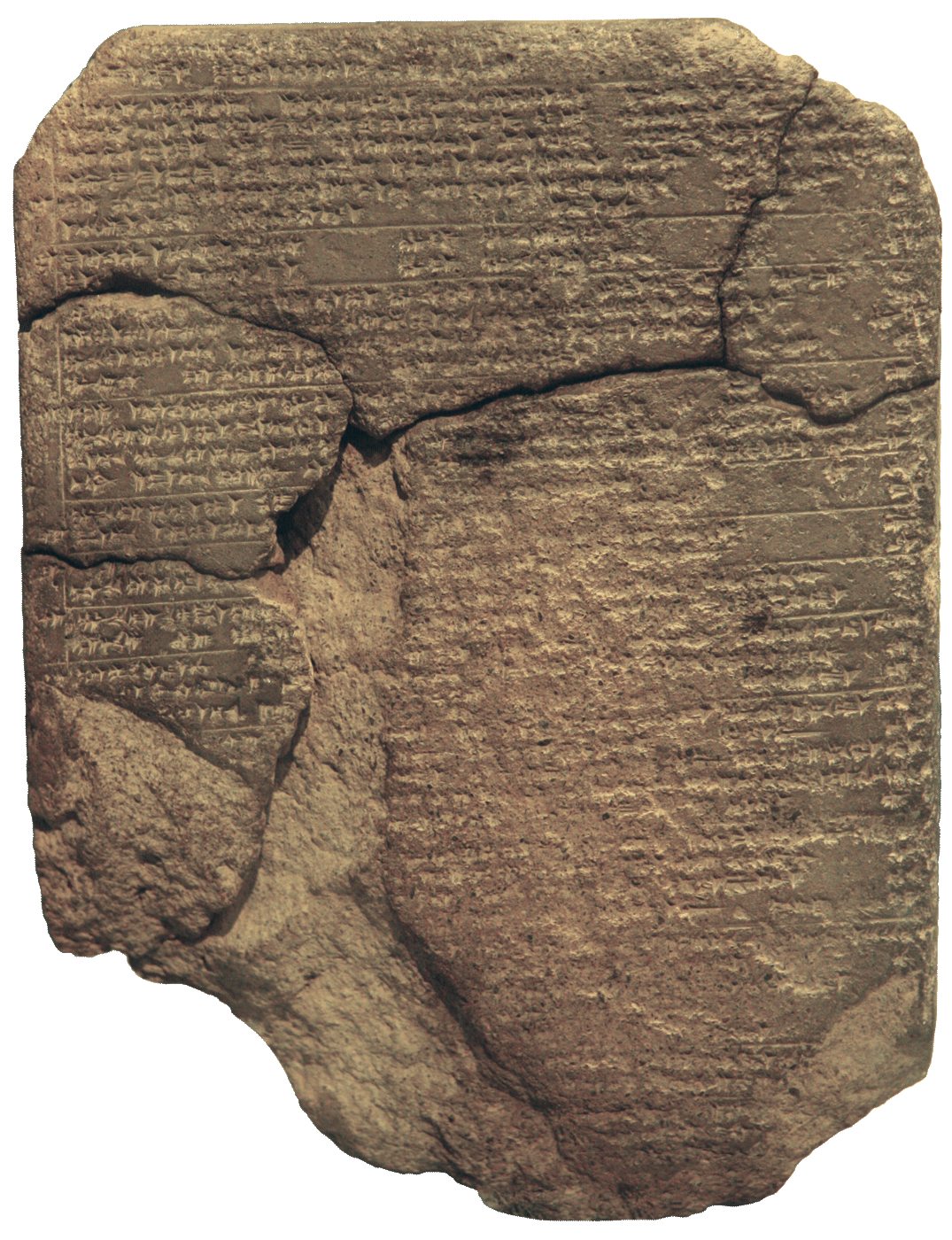
Vassal treaty between the Hittite king Mursili II and Talmi-sharruma of Aleppo (c. 1300 BC). [ Copyright Baker Photo Archive. Courtesy of the British Museum. ]
Using the repeated rhetorical markers of These are the words (1:1), This is the law (4:44), and These are the terms (29:1), it is possible to detect the three key speeches/sermons of Moses, each with a distinct focus: learning from history (1:14:43), explaining the law of God (4:4428:68), and renewing the covenant (29:130:20).
The archaeological discovery of some fifty to sixty extrabiblical treaties of sovereign kings with their vassal kings from around 1400 BC has provided us with echoes of a similar structure for Deuteronomy. Especially significant have been the Hittite treaties from the second millennium BC, whose patterns are paralleled section for section in the same order as those in Deuteronomy.

